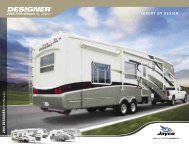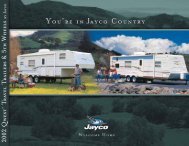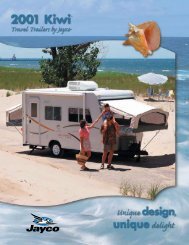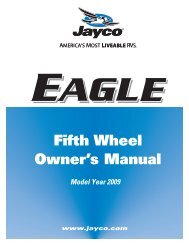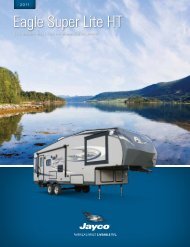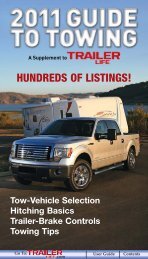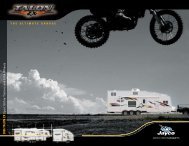Read all instructions in this manual and component part - Jayco
Read all instructions in this manual and component part - Jayco
Read all instructions in this manual and component part - Jayco
Create successful ePaper yourself
Turn your PDF publications into a flip-book with our unique Google optimized e-Paper software.
Before you travel...WEIGHING INSTRUCTIONSAs your pack<strong>in</strong>g <strong>and</strong> load<strong>in</strong>g rout<strong>in</strong>e becomes more familiar from experience, physic<strong>all</strong>yweigh<strong>in</strong>g your trailer may not be necessary before each trip. While you are develop<strong>in</strong>g aprocess, it is imperative that you verify compliance with<strong>in</strong> the weight rat<strong>in</strong>gs. Overload<strong>in</strong>gyour RV voids the <strong>Jayco</strong> limited, express warranty <strong>and</strong> the warranties of many <strong>component</strong><strong>part</strong> manufacturers. The follow<strong>in</strong>g process will aid with weigh<strong>in</strong>g your trailer. Keep <strong>in</strong>m<strong>in</strong>d that <strong>in</strong>dividual scales will operate differently. The surround<strong>in</strong>gs of the scale need tobe adequate to accommodate weigh<strong>in</strong>g each side of your trailer. Please read through <strong>all</strong>weigh<strong>in</strong>g <strong><strong>in</strong>structions</strong> before you beg<strong>in</strong>. If you have further questions, consult with your<strong>in</strong>dependent, authorized dealer or the scale operator.Your recreation vehicle must be weighed fully loaded, that is, with food, cloth<strong>in</strong>g, fuel,water, propane, supplies, etc.TO PROPERLY WEIGH YOUR RECREATION VEHICLE1. First, weigh the recreation vehicle <strong>in</strong>clud<strong>in</strong>g the tongue weight, while detached fromthe tow vehicle. This actual over<strong>all</strong> weight must be less than or equal to the GVWRfor safe operation. If the over<strong>all</strong> weight is greater than the GVWR, some contentsmust be removed until the actual over<strong>all</strong> weight is less than or equal to GVWR.2. Next, hitch the recreation vehicle to your tow vehicle. Weigh the recreation vehicle<strong>and</strong> the tow vehicle to determ<strong>in</strong>e the GCW. Make sure that <strong>this</strong> rat<strong>in</strong>g is less than orequal to the GCWR as specified by the manufacturer of your tow vehicle. If <strong>this</strong>over<strong>all</strong> weight is greater than the GCWR, some contents must be removed to br<strong>in</strong>gthe comb<strong>in</strong>ation <strong>in</strong>to compliance with the listed rat<strong>in</strong>gs.3. Next, weigh the recreation vehicle, while attached, but exclud<strong>in</strong>g the tow vehicle.This will result <strong>in</strong> the actual weight that is exerted on <strong>all</strong> of the recreation vehicletires. This weight may be subtracted from the over<strong>all</strong> recreation vehicle weightGVWR to determ<strong>in</strong>e the actual “tongue” weight.4. Next, with the recreation vehicle still attached to the tow vehicle, each wheel positionshould then be weighed separately to ensure each tire is not overloaded.To Determ<strong>in</strong>e the Wheel Position Weight• Pull the recreation vehicle onto the scale so only one tire is on the scale. Record theweight. Your trailer must rema<strong>in</strong> as level as possible on the scale (even though anaxle or side is not physic<strong>all</strong>y on the scale). Obviously, to obta<strong>in</strong> the side-to-sideweights, there must be enough space on either side of the scale to accommodate therecreation vehicle be<strong>in</strong>g <strong>part</strong>i<strong>all</strong>y off the scale.• To calculate the opposite side of the vehicle wheel position weight, subtract the firstside’s weight from the weight determ<strong>in</strong>ed <strong>in</strong> step #3.If there is a difference <strong>in</strong> the weights on one side of the vehicle as compared to weights onthe other side, <strong>component</strong>s (tires, wheels, brakes, spr<strong>in</strong>gs, etc.) on the heavier side could beoverloaded, even though the total axle load is with<strong>in</strong> the GAWR. It is important toredistribute the load to avoid <strong>component</strong> failure, to improve the h<strong>and</strong>l<strong>in</strong>g characteristics ofthe vehicle <strong>and</strong> to not void the warranty.With these actual weights, it is now possible to compare them aga<strong>in</strong>st the GAWR, GVWR<strong>and</strong> tire capacities.Jay Flight Conventional Travel Trailer <strong>and</strong> Fifth-Wheel Travel Trailer 25



